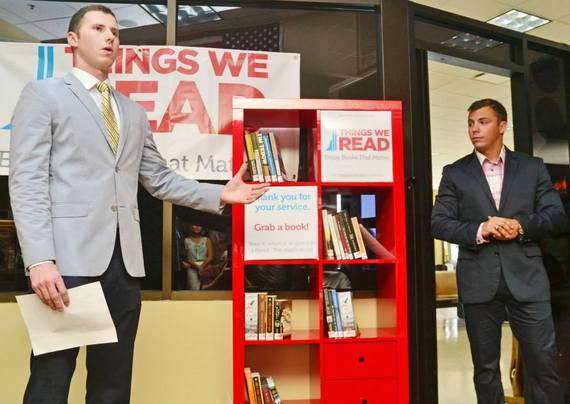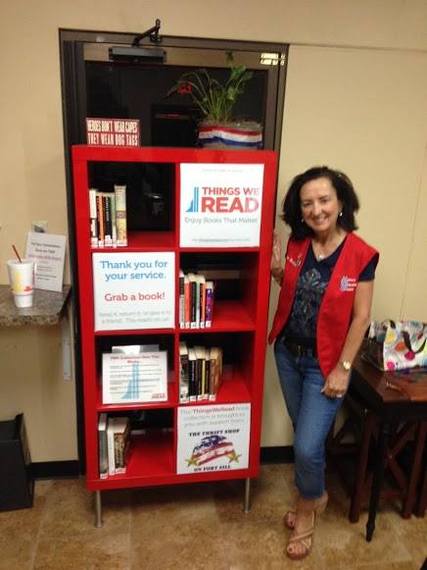To be sure, there are many ways one can try to change and help their community, big or small. Admittedly, there are more effective and less effective ways to do this, but even in some of the most tangible, effective forms of outreach, like starting a non-profit; the path to success is unsure and tough to navigate.
We learned this through founding our non-profit, Things We Read. The initial idea of our organization took shape when we were on deployment to Iraq in 2011 as platoon leaders, to encourage reading and a love of education on the front lines with our soldiers, back home with veterans, and in communities in need, through collecting the book recommendations of famous people, and posting them to our website.
As we grew, we were granted our 501(c)(3) tax exempt status, and were then able to donate recommended books free of charge to these communities.
It's been a year since we were a newly minted public charity, and in retrospect, the sometimes very frustrating endeavor has been incredibly gratifying. If you have a cause you're truly passionate about, we recommend doing the leg-work to start your own non-profit.
Here are a few lessons along the way that are worth sharing.
1. Don't Jump the Gun!
We learned this the hard way. When you're creating a non-profit, there are some timelines you can expedite, and some you can't. This can be a brutal lesson to learn, and is best illustrated by a story: When we were first submitting our founding paperwork, and applying for 501(c)(3) status with the IRS, we were told it would take about 3 months to get approved. (A sub-lesson here: be proactive with the IRS. There are a number of expeditious requests and other means of pushing your paperwork through, and of course, nothing replaces talking to a person about your application specifically. Nag them, politely of course, but stay on top of it and be prepared to wait on the phone for at least 45 minutes before being connected).
About the time we were applying for our 501(c)(3) status, we began reaching out to potential supporters to partner with we began talking with LeVar Burton and the folks over at Reading Rainbow. It became apparent, almost intuitive, that our missions were mutually supporting. After exchanging some emails, we had a great phone call with LeVar. An entertainer, service minded entrepreneur, and philanthropist, LeVar was also an army brat, born on base in Germany. The cause of soldier literacy resonated with him, and he was quick to offer his full support and the weight of his celebrity to bring soldier literacy to the public eye.
We remember walking away from that conversation realizing that he was absolutely the perfect person to talk with about our organization, and before we finished our phone call, we still remember his generous offer, "would you be willing to consider me a part of the Things We Read team?" The answer was a resounding "yes" from us, however, after nearly 10 months of waiting for approval from the IRS, we had fallen off his radar and lost the opportunity to bring him on board (LeVar, if you're reading this, there's still plenty of room)! And if you've been paying attention to the news lately, you're aware that he recently launched a kick-starter campaign to bring Reading Rainbow to schools across the country. He rose over $1 million in the first day, and another $2.5 million shortly thereafter. Clearly, it would be incredible to have him on the TWR team, but until you have all your ducks in a row, don't start recruiting help or committing to projects.
A lot of times when considering people outside your organization's structure, you will have a one-time shot to engage them and keep them interested. Maybe it's disappointing, even frustrating, but it's true, so don't waste that opportunity--especially when you don't know how long you're going to be stuck waiting. People are busy, and they'll move on to what's next.
2. Know Your Resources
Another challenge most non-profit start-ups will face is operating with a limited budget, sometimes nothing, and we were no different. Our entire team is made up of volunteers, and
raising the type of money to put a professional face on our organization wasn't easy.
For modern non-profits, the first impression people will garner of your organization, and sometimes the deciding factor in whether or not they'll associate themselves with you, let alone support you, is your website. You'll need a website that does justice to your mission, and gives people a chance to contribute and play a role in your cause. Websites can be expensive and you may not have the budget; we know this pain and found the best way to ensure you have the necessary appearance is to leverage already existing platforms.
Plenty of options are available for the budget-minded non-profit. From pricey-and-feature-packed to free-and-feature-slim, many of the platforms don't require any prior knowledge of web development. The fundamental features you need your website tool to provide are a way to manage your content (a CMS, or "content management system..."), and plenty of robust templates to apply to your layout. Also helpful is the ability for you to drag-and-drop items around your webpage, when designing it- otherwise you'll need to know HTML or another programming language. We used Tumblr for our initial website, but others exist that can help such as GoDaddy, and Weebly to name a few. The bottom line is that it doesn't matter what you use, but in order to reach the audience your cause deserves and bring together the support adequate of your mission, the site and outreach cannot appear amateurish.
3. Don't Be Shy.
Telling people about your cause and asking them to donate can be intimidating. Plenty of start-up non-profit directors and CEOs we've talked with feel leery about asking friends, family, and community to donate and spread news about their outreach. This is exactly the wrong attitude.
If you believe in a cause deeply enough to found a non-profit to support it, the last thing you want is to be embarrassed to ask for help. And the first people you want to engage are your friends and family. Remember, you're not asking your people to contribute their hard-earned money so you can go on vacation to Cancun- you're asking them to provide to the life blood of your organization. Simply put, you've seen a need that requires addressing, and you've figured out a good way to address it. That's not something to be bashful about.
This is especially important to keep in mind in developing an involved base. You can't achieve much without an engaged group working to forward the cause. Your volunteers, supporters and donors need to be quality, and committed to your mission. And who better to grow a base like that with, than your friends and family?
A sub lesson of this section: the cold call -- or with our generation, the cold e-mail, cold tweet or even cold LinkedIn outreach. There are so many resources out there, so do your due-diligence, get to researching and find the people and organizations you think would get behind your mission. If you have a personal connection, use it, but if not, reach out through other means you found during your research. Tim Ferriss discusses different techniques to successfully do this in his blog, Four Hour Work Week.
4. Always Say "Thanks"
No matter what kind of support people provide, whether monetary, volunteer hours, donations-in-kind, or otherwise, always say "Thank You." The world is a busy place, and whether you reach out to people or people reach out to you, anyone who helps you is offering you two incredibly rare gifts: their time and their trust. Sometimes saying "thanks" may be as simple as shooting them a "thank you" email or giving them a call, but even more uncommon and surely more appreciated is an old-fashioned "Thank You" note.
Acknowledging your supporters is a strength any organization has the capability to execute, even ones with limited budgets. Post their names or logos on your site, tweet about them, tag them in your social media, ensure they are mentioned wherever and whenever possible, publicly. Do whatever you can to ensure the people giving you whatever they offer know they are appreciated.
If you have a more generous budget, consider a few options to allow you to take this lesson even further. Keeping track of addresses and sending hard-copy notes isn't always easy, especially with big events and fundraising campaigns when you have lots of people to thank. Services exist that will let you type your thank you notes in your browser, and not only manage these but write the note down on paper, throw it in a nice envelope, put a stamp on it and mail it off. One such service that we have used that does just this is called BOND. Again, this also harkens back to knowing your resources.
Those are our top four lessons. There's plenty more that could be said about the constant learning that takes place while running a non-profit, but this list captures our most important and often overlooked learning points. Whatever your ultimate goal, if you're trying to improve your community, the world needs more people like you- so keep pressing forward. We hope these help. Thanks for making a difference, and good luck in your efforts.


